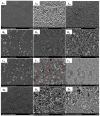The Structural, Thermal and Morphological Characterization of Polylactic Acid/Β-Tricalcium Phosphate (PLA/Β-TCP) Composites upon Immersion in SBF: A Comprehensive Analysis
- PMID: 38475402
- PMCID: PMC10934208
- DOI: 10.3390/polym16050719
The Structural, Thermal and Morphological Characterization of Polylactic Acid/Β-Tricalcium Phosphate (PLA/Β-TCP) Composites upon Immersion in SBF: A Comprehensive Analysis
Abstract
Biocomposite films based on PLA reinforced with different β-TCP contents (10%, 20%, and 25%wt.) were fabricated via solvent casting and immersed in SBF for 7, 14, and 21 days. The bioactivity, morphological, and thermal behavior of composites with immersion were studied using scanning electron microscopy (SEM), energy-dispersive X-ray (EDX) microanalysis, weight loss (WL), X-ray diffraction (XRD), Fourier transform infrared spectroscopy (FTIR), differential scanning calorimetry (DSC), thermogravimetric analysis (TGA), and gel permeation chromatography (GPC). This broad analysis leads to a deeper understanding of the evolution of the polymer-filler interaction with the degradation of the biocomposites. The results showed that β-TCP gradually evolved into carbonated hydroxyapatite as the immersion time increased. This evolution affected the interaction of β-TCP with PLA. PLA and β-TCP interactions differed from PLA and carbonated hydroxyapatite interactions. It was observed that β-TCP inhibited PLA hydrolysis but accelerated the thermal degradation of the polymer. β-TCP retarded the cold crystallization of PLA and hindered its crystallinity. However, after immersion in SBF, particles accelerated the cold crystallization of PLA. Therefore, considering the evolution of β-TCP with immersion in SBF is crucial for an accurate analysis of the biocomposites' degradation. These findings enhance the comprehension of the degradation mechanism in PLA/β-TCP, which is valuable for predicting the degradation performance of PLA/β-TCP in medical applications.
Keywords: crystallinity; gel permeation chromatography; polylactic acid; solvent casting technique; β-tricalcium phosphate.
Conflict of interest statement
The authors declare no conflicts of interest.
Figures













Similar articles
-
Influence of the addition of β-TCP on the morphology, thermal properties and cell viability of poly (lactic acid) fibers obtained by electrospinning.Mater Sci Eng C Mater Biol Appl. 2015;52:135-43. doi: 10.1016/j.msec.2015.03.055. Epub 2015 Mar 26. Mater Sci Eng C Mater Biol Appl. 2015. PMID: 25953550
-
Thermal and mechanical properties of polyethylene glycol (PEG)-modified lignin/polylactic acid (PLA) biocomposites.Int J Biol Macromol. 2024 Mar;262(Pt 1):129997. doi: 10.1016/j.ijbiomac.2024.129997. Epub 2024 Feb 8. Int J Biol Macromol. 2024. PMID: 38340934
-
Effects of Inorganic Fillers on the Thermal and Mechanical Properties of Poly(lactic acid).Int J Polym Sci. 2014;2014:827028. doi: 10.1155/2014/827028. Int J Polym Sci. 2014. PMID: 25717339 Free PMC article.
-
Biomechanical Evaluation of an Injectable Alginate / Dicalcium Phosphate Cement Composites for Bone Tissue Engineering.J Mech Behav Biomed Mater. 2021 Jun;118:104439. doi: 10.1016/j.jmbbm.2021.104439. Epub 2021 Mar 4. J Mech Behav Biomed Mater. 2021. PMID: 33691231
-
Structure and Properties of Polylactic Acid Biocomposite Films Reinforced with Cellulose Nanofibrils.Molecules. 2020 Jul 21;25(14):3306. doi: 10.3390/molecules25143306. Molecules. 2020. PMID: 32708238 Free PMC article.
Cited by
-
Review of the Synthesis and Degradation Mechanisms of Some Biodegradable Polymers in Natural Environments.Polymers (Basel). 2024 Dec 30;17(1):66. doi: 10.3390/polym17010066. Polymers (Basel). 2024. PMID: 39795468 Free PMC article. Review.
-
Bioglasses Versus Bioactive Calcium Phosphate Derivatives as Advanced Ceramics in Tissue Engineering: Comparative and Comprehensive Study, Current Trends, and Innovative Solutions.J Funct Biomater. 2025 May 3;16(5):161. doi: 10.3390/jfb16050161. J Funct Biomater. 2025. PMID: 40422826 Free PMC article. Review.
-
Highly Porous 3D Nanofibrous Scaffold of Polylactic Acid/Polyethylene Glycol/Calcium Phosphate for Bone Regeneration by a Two-Step Solution Blow Spinning (SBS) Facile Route.Polymers (Basel). 2024 Oct 29;16(21):3041. doi: 10.3390/polym16213041. Polymers (Basel). 2024. PMID: 39518250 Free PMC article.
References
-
- Ranakoti L., Gangil B., Bhandari P., Singh T., Sharma S., Singh J., Singh S. Promising Role of Polylactic Acid as an Ingenious Biomaterial in Scaffolds, Drug Delivery, Tissue Engineering, and Medical Implants: Research Developments, and Prospective Applications. Molecules. 2023;28:485. doi: 10.3390/molecules28020485. - DOI - PMC - PubMed
-
- Taib N.-A.A.B., Rahman M.R., Huda D., Kuok K.K., Hamdan S., Bakri M.K.B., Julaihi M.R.M.B., Khan A. A Review on Poly Lactic Acid (PLA) as a Biodegradable Polymer. Polym. Bull. 2023;80:1179–1213. doi: 10.1007/s00289-022-04160-y. - DOI
Grants and funding
LinkOut - more resources
Full Text Sources

